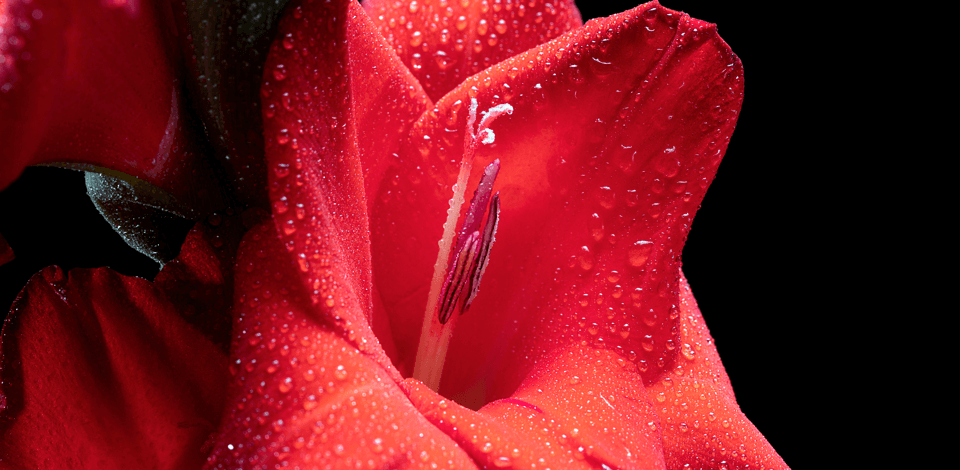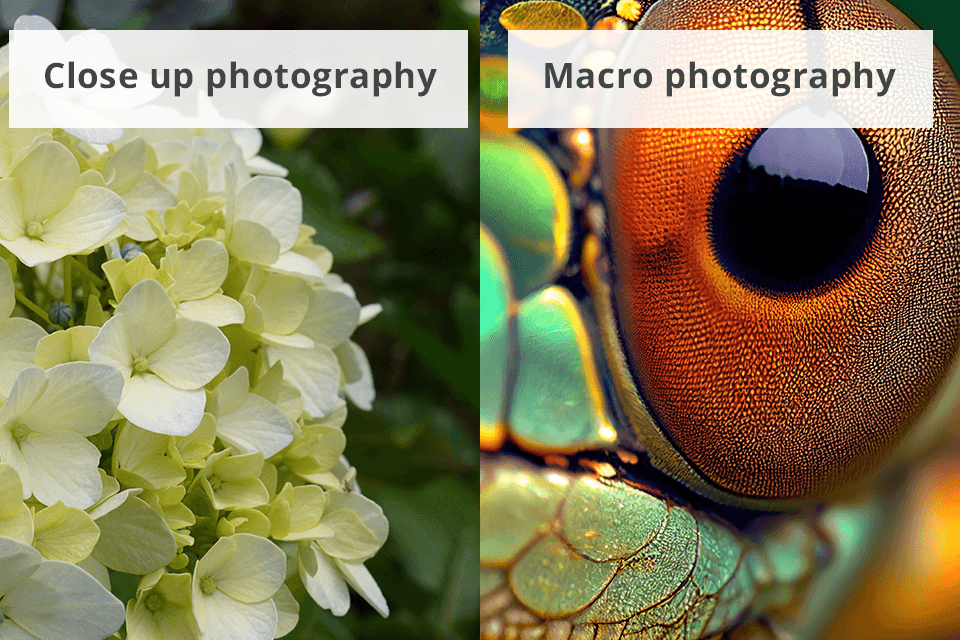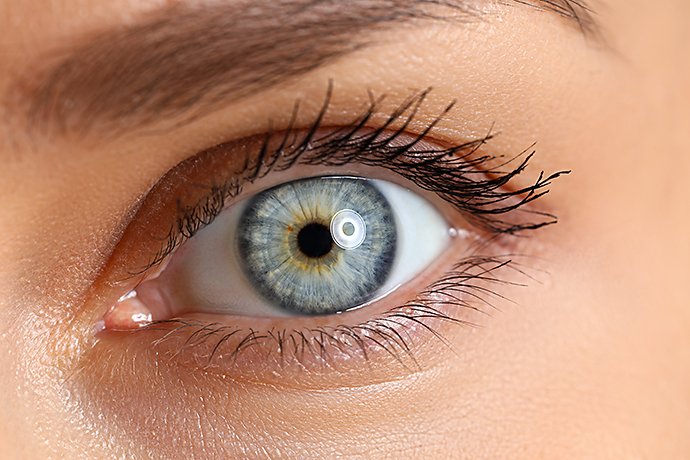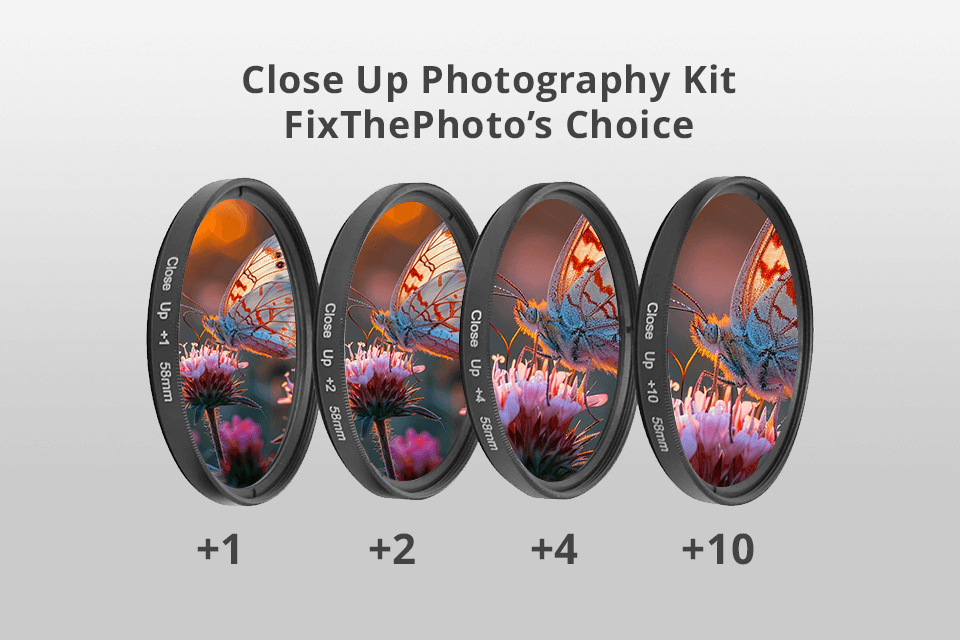
Close up photography is a shooting technique that implies zooming in on the tiny details that often go unnoticed. When a photographer gets close to a subject, they can see and capture hidden textures, patterns, and features that look stunning in images.
By sticking to this technique, you can capture the world from a whole new perspective. When approaching your subject as much as possible, you can magnify even the tiniest elements, making them the centerpiece of your shot. Whether you're fascinated by the unique patterns of a flower or the texture of a weathered rock, you can depict their beauty in pictures.
Distinctive features of close ups:

A common misconception among novice photographers is that close up and macro photography are the same thing. However, there are clear distinctions related to the level of magnification and technical aspects:
| Close Up | Macro | |
|---|---|---|
|
Magnification level |
Less than life-size (less than 1:1 magnification)
|
Life-size or greater (1:1 magnification or higher)
|
|
Lens requirements
|
Can be achieved with standard or zoom lenses
|
Requires a dedicated macro lens for 1:1 magnification |
|
Detail & focus |
Produces larger, clearer views of subjects but often lacks the fine, microscopic details
|
Captures minute details, textures, and patterns at very close range |
|
Subject size
|
Larger subjects, or smaller subjects captured without extreme magnification |
Extremely small subjects like insects, flowers, or tiny objects
|
|
Lighting
|
Natural or simple artificial lighting works well
|
May require ring lights, diffusers, or special lighting for fine details and even exposure
|
|
Depth of field |
Relatively deeper depth of field compared to macro
|
Very shallow depth of field, requiring precise focus |
|
Use cases
|
Portraits, product photography, flowers, larger objects
|
Extreme close-ups of insects, textures, tiny objects, and fine details
|
Extreme close-up photography bridges the gap between close-up and macro photography. It's a technique that allows you to showcase the tiniest elements of your subject with incredible clarity.
To get extremely close up in photography with a macro lens, you should take the following steps:
 If you haven’t managed to achieve the desired clarity of details or textures during shooting, don’t get discouraged. You can still get the needed result while editing your pictures in Photoshop.
If you haven’t managed to achieve the desired clarity of details or textures during shooting, don’t get discouraged. You can still get the needed result while editing your pictures in Photoshop.
Close up photography is a versatile genre with several subcategories. Each type of close up photography has its own specific subjects, techniques and equipment requirements. Figure out which niche interests you more and hone your skills.

Subjects: Flowers, insects, plants, leaves, water droplets, and small animals.
Close up nature photography reveals the hidden world of textures and details. By zooming in on flowers, leaves, and insects, we can discover a world of textures and patterns that are often overlooked. It's a rewarding but challenging field of nature photography that requires patience, attention to detail, and a love for the natural world.
Close-up flower photography is a fantastic choice for beginner photographers. Thanks to their vibrant colors and textures, you can easily find focus, while their stillness means you can take your time to compose a shot. To achieve success in close up flower photography, shoot flowers at eye level and use soft, diffused lighting to highlight their petals.
Subjects: Everyday objects, food, textures, fabrics, jewelry, or any inanimate object.
Close-up still life photography is aimed at showing minute details of objects and scenes. It's a popular technique in commercial photography, used to showcase products and materials in a visually appealing way. Photographers can control the lighting and composition, thus, emphasize the textures, shapes, and fine details of their subjects.

Subjects: Faces, hands, eyes, or any part of a person’s body.
Portrait photography when combined with a close up shooting technique is a powerful way to capture the essence of a person. By focusing on their facial features or other body parts, photographers can convey emotions, textures, and expressions in a way that's both intimate and compelling. Close up portraits are often referred to as headshots and used in professional photography to create memorable and emotionally resonant images.
Many experts are fond of eye photography because they believe the eyes are a window to the soul. To achieve impressive close up eye photography results, use a standard zoom lens and a shallow depth of field. Thus, you can isolate the eye, making it the central part of a photo. Check out images so there is no camera reflection in them.

Subjects: Any object or surface that creates patterns, textures, or unusual forms when viewed closely (e.g., fabric, metal, glass, or skin).
Abstract close-up photography takes a subject and zooms in so closely that it's hard to recognize. Instead, viewers see the details like textures, colors, and patterns. This creative style encourages us to look at the world in a new way. architecture photography is a great example of abstract close-ups.
When photographing interiors, it's important to highlight the space's most attractive and unique features. Whether you are taking photos for real estate listings to personal projects, get the most out of natural light. If you happen to work in low-light conditions, use a wide aperture and a standard zoom lens. Thus, you can still receive clear, detailed shots.

Subjects: Small animals, insects, reptiles, and birds.
Wildlife photography is related to nature close up photography in a way. When taking such pictures, your task is to observe and photograph animals in their natural habitats. Typically, you need to use telephoto or macro lenses to capture the fine details without interfering with animals.

To dive into the world of close up photography, you need the right tools. Fortunately, many DSLR and mirrorless cameras work with zoom lenses, allowing you to zoom in and capture intricate details.
Standard zoom. They offer a fantastic balance of versatility and affordability for close-up photography. Available in various focal lengths, they let you capture subjects from a distance or get up close enough for a mesmerizing shot. The popular 70-200mm range is particularly well-suited for producing natural, well-lit photos. The key features are:
Macro. They are designed for extreme close up photography experiments. Macro lenses cover a broad range of focal lengths, meaning, you can achieve impressive sharpness and texture in your photos. The key features are:
Telephoto. They are a must-have for capturing beautiful close-ups from afar. Telephoto lenses perfectly zoom in on distant subjects, making them ideal for wildlife photography. With their powerful magnification, you can take detailed shots from a safe distance. However, keep in mind that their high zoom can sometimes result in a shallower depth of field. The key features are:
Other equipment that may come in handy:
Extension tubes: If you don’t own a macro lens, extension tubes can be a budget-friendly option. These tubes fit between your camera and lens, allowing you to focus closer and capture more detailed shots. They’re a great way to experiment with close up photography of flowers or other items without breaking the bank.
Tripod: A tripod is essential for taking sharp close-up photos. It helps you stabilize your camera, preventing blurriness, especially when using slower shutter speeds or smaller apertures to achieve a greater depth of field.
Ring light or external flash: Lighting plays a crucial role in close up photography. While natural light can be a beautiful source, it often produces unwanted shadows and inconsistencies. To achieve a more even and controlled illumination, consider using a ring light or an external flash diffuser. These tools help soften shadows and highlight fine features.
Focus on the details. When photographing subjects up close, even the slightest shift in focus can make a huge difference. To ensure your images are crisp and clear, have precise focus. Manual focus gives you complete control over where the camera focuses, while focus peaking (if your camera has it) highlights the sharpest areas of your image, e.g., flower petals, butterfly wings, etc.
Shallow depth of field. One of the keys to getting arresting close-up photos is to understand and control aperture and depth of field. By using a wide aperture (like f/2.8 or f/4), you can create a beautiful, blurry background that isolates your subject and draws attention to the intricate details. This technique, known as shallow depth of field, is a powerful tool for creating stunning close-ups.
Use a smaller aperture for more detail. To capture unique textures and complex structures in your close-up photos, choose a smaller aperture. Thus, you can increase the depth of field and more of your subject will be in focus. F/8, f/11, and f/16 are ideal aperture settings for achieving this effect.
Build your composition attentively. Flower photography close up or other subgenres are more than just technical skills. You also need to pay attention to composition to enhance the aesthetic impact of your shots. Experiment with different angles, leading lines, and natural framing to draw the viewer's eye. Don’t neglect classic composition rules like the rule of thirds. Such methods can still help you create more interesting images.
Stabilize your camera. To prevent blurry close up photos, it's crucial to make your camera stable. Use a tripod and a remote shutter release or the self-timer to avoid camera shake. Such movement is typically more noticeable at close distances.
Think outside the box. Don’t limit yourself to traditional angles when shooting close-ups. Get creative by experimenting with different perspectives. Try shooting from below, above, or from the side to add a unique dimension to your subject.
To take beautiful close up photos, you need a lens with a focal length longer than 42 millimeters.
42 mm. While a standard 42mm kit lens is a great starting point, it may not be powerful enough for extremely close shots. Still, it suffices for standard close up images.
50 mm. Using 50 mm lens is ideal for close-up photography in low light. Such a lens has a wide aperture, so it captures more light. This is important if you frequently photograph in dim conditions like dawn or dusk. Plus, the 50mm focal length is close to the human eye's perspective, so your photos will have a natural and realistic look.
85 mm. An 85mm lens is a popular choice among portrait and landscape photographers due to its fast aperture and compact size. It brags about versatility, so you can capture both close-up portraits and wider-angle scenes. In other words, this is an ideal lens for taking shoulder-length portraits, cityscapes, nature shots, and more.
100 mm. If you want to take your close up photography to the next level, a 100mm lens is a great investment. It is capable of capturing sharp images, especially in portrait and flower close up photography. It is also equally helpful for nature and family images.
100+ mm. Once you go beyond 100mm, you're entering the world of telephoto lenses. These long lenses allow you to capture subjects from a distance, often hundreds of meters away. However, they tend to have a narrower depth of field, meaning less of the image will be in focus.